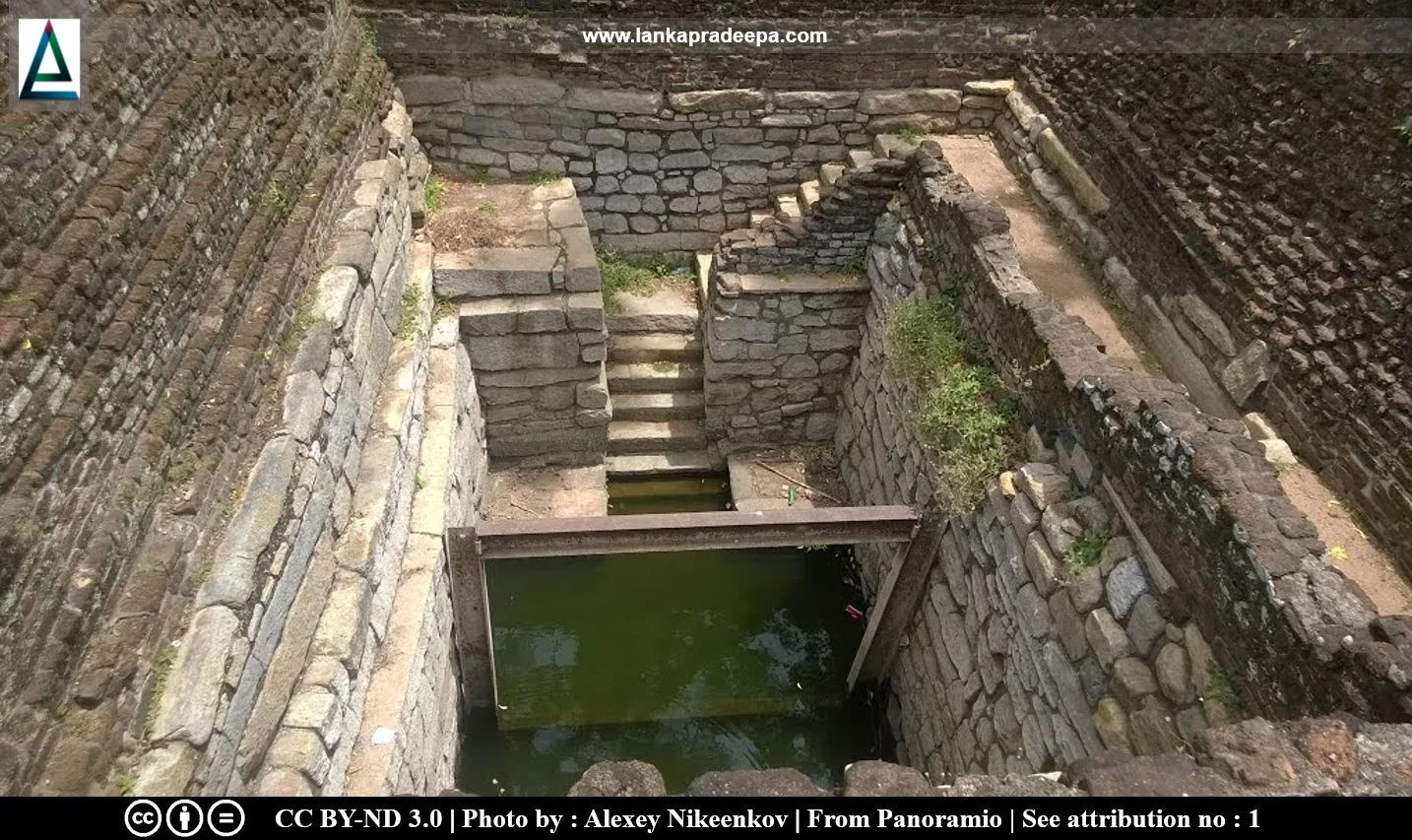
Mahapali Alms-Hall or Mahapali Refectory (Sinhala: මහාපාලි දාන ශාලාව) is a ruined building located in the Inner City of Anuradhapura, Sri Lanka.
History
Mahapali
was the royal alms hall where the daily alms were provided for the
monks at the king's expense during the Anuradhapura Period (Nicholas,
1963). The term "Mahapali" may have derived from the custom of monks
coming for their food in a queue (Pela)
according to their seniority (Jayasuriya, 2016). Two 10th-century inscriptions found on the large stone canoe in the alms hall contain the
word Maha-pela which means the "great queue" (Nicholas, 1963).
The practice to supply meals for the monks from the royal kitchen was begun since the time of King Devanampiyatissa [(247-207 B.C.) Jayasuriya, 2016]. Therefore, Devanampiyatissa is credited with constructing the original Mahapali alms hall adjacent to the royal palace (Nicholas, 1963; Paranavitana, 1936).
Since then, the Mahapali alms hall was maintained, restored or rebuilt by successive kings up to the end of the Anuradhapura Period (Paranavitana, 1936). The Chinese pilgrims Fa-Hien and Hieun Tsiang both refer to the alms hall maintained by the Sinhalese kings within the royal palace (Paranavitana, 1936). As recorded in chronicles, kings such as Khujjanaga (c. 245-247 A.D.), Upatissa I (365-406 A.D.), Mahanaga (406-428 A.D.), Dhatusena (455-473 A.D.) continued the alms-giving tradition from the Mahapalai alms hall (Nicholas, 1963; Paranavitana, 1936). King Aggabodhi I (571-604 A.D.) made a bronze canoe for the Mahapali and King Aggabodhi II (604-614 A.D.) also set up a canoe for the gifts of rice (Paranavitana, 1936). King Silameghavanna (619-628 A.D.) enlarged the Mahapali alms hall but one of his successors, Dathopatissa I (639-650 A.D.) gave the canoes in the alms hall to his Tamil soldiers (Paranavitana, 1936). Other successive kings including Kassapa II (650-659 A.D.), Dathopatissa II (664-673 A.D.), Aggabodhi IV (673-689 A.D.), Mahinda I (738-741 A.D.), Dappula II (815-831 A.D.), Aggabodhi IX (843-846 A.D.), and Udaya II (887-898 A.D.) contributed in the development of the alms hall (Nicholas, 1963; Paranavitana, 1936). King Mahinda IV (956-972 A.D.) re-built the Mahapali alms hall after it was burnt down by the South Indian Cola army who invaded Anuradhapura in the reign of King Udaya III [(935-938 A.D.) Paranavitana, 1936].
After the downfall of the Anuradhapura Kingdom, the alms hall was fallen into decay. The materials of the building have been removed from this site later to construct other buildings (Jayasuriya, 2016; Paranavitana, 1936).
The stone canoe and inscriptions
A large stone canoe can be seen at this site. It has been used as a receptacle for boiled rice intended for feeding Buddhist monks (Paranavitana, 1936). Stone canoes similar to this have also been found in the alms halls at Abhayagiriya, Jetavanaramaya, Maha Viharaya, and Mihintale.
Three inscriptions belonging to the last quarter of the 10th century have been found engraved on the outer face of the north end of this canoe (Paranavitana, 1933). The first inscription comprises eleven lines of writing while the second and third have three lines of writings each (Paranavitana, 1933). Of the three inscriptions, the first one refers to a donation of alms by the monks to the workers who were restoring the Jetavanarama Stupa (Jayasuriya, 2016; Wikramagamage, 2004).
Period: 10th century A.D. Script: Medieval Sinhala Language: Medieval SinhalaTranscript: Me Ma[hapela] bat [ga]nna tak denamo a[pa] lada bat [ko]tas bat Dena vehe[ra] dagaba karana ...>>Translation: We, all of us, who receive rations at this Mahapali, have given our shares of rice for the new works being carried on at the Stupa of the Jetavana monastery. Those who violate this shall take [upon themselves] the sins committed by [all] the inhabitants of the land. [They also] shall incur the sins committed by a killer of goats at Mahavutu (Mahatittha: modern Tiruketiswaram near Mannar).Citation: Paranavitana, 1933. pp.132-133.
Other ruins
A slab inscription of King Mahinda IV (956-972 A.D.) and a ruined building believed to be the ancient Temple of the Tooth Relic have been found adjacent to the site of the Mahapali alms hall (Paranavitana, 1936). Also, an ancient well that probably supplied water to the alms hall has been unearthed from this site (Jayasuriya, 2016; Wikramagamage, 2004). Although this well has features of the 10th century A.D., a worn inscription discovered from a stone slab of this well reveals that it probably has been dug in the 6th century A.D. (Paranavitana, 1936).
See also
Attribution
1) Well at Mahapali by Alexey Nikeenkov is licensed under CC BY-ND 3.0.
References
1) Jayasuriya, E., 2016. A guide to the Cultural Triangle of Sri Lanka. Central Cultural Fund. ISBN: 978-955-613-312-7. p.48.
2) Nicholas, C. W., 1963. Historical topography of ancient and medieval
Ceylon. Journal of the Ceylon Branch of the Royal Asiatic Society, New
Series (Vol VI). Special Number: Colombo. Royal Asiatic Society (Ceylon
Branch). pp.139-140.
3) Paranavitana, S., 1933. (Edited and translated by Wikramasinghe, D.M.D.Z.; Codrington, H.W.) Inscriptions on the stone canoe within the Citadel Anuradhapura.
Epigraphia Zeylanica: Being Lithic and Other Inscriptions of Ceylon: Vol. III. Printed at the Department of Government Printing, Sri Lanka
(Ceylon) for the Archeological Department. pp.131-137.
4) Paranavitana, S., 1936. The excavation in the Citadel of Anuradhapura.
Memoirs of the Archaeological Survey of Ceylon. Vol. III. Ceylon
Government Press. Colombo. pp.2,24-36.
5) Wikramagamage, C., 2004. Heritage of Rajarata: Major natural, cultural,
and historic sites. Colombo. Central Bank of Sri Lanka. p.50.
Location Map
This page was last updated on 18 February 2023

